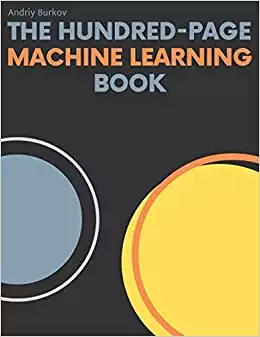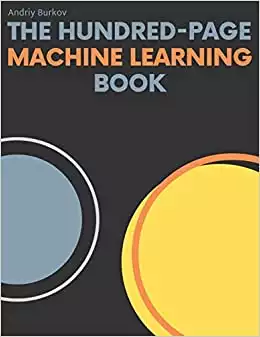Introduction
Can you learn everything you need to know about machine learning techniques within a book that only spans one hundred pages? This is the ambitious goal of The Hundred-Page Machine Learning Handbook by Andriy Burkov. But does this introduction to machine learning deliver? Here is our verdict.
Also Read: Top 10 Artificial Intelligence Books for Beginners in 2022.
The Hundred-Page Machine Learning Book
Written by an experienced practitioner of machine learning, this book aims to introduce readers to core concepts of artificial intelligence (AI) and machine learning (ML) in an accessible manner. Industry experts believe that the book is a success. Amazon’s Head of Data Science, Karolis Urbonas calls it a “great introduction to machine learning from a world-class practitioner.” eBay’s Head of Engineering, Sujeet Varakhedi, and LinkedIn’s VP of AI, Deepak Agarwal agree.
As far as books on machine learning go, this is an excellent book and a solid introduction to the field, including key concepts in machine learning. It is also written in an easy-to-understand manner that makes it possible to read in a single sitting.
Who is the book for?
In short, everyone. Machine learning algorithms and artificial intelligence are becoming part of almost everyone’s personal and professional lives. Understanding major machine learning approaches will help not only engineers embrace emerging technologies.
This book on machine learning is also an excellent resource for academics. As a resource for academics, Burkov’s book covers science concepts, statistical concepts, and practical concepts of ML, all the while remaining readable for those without programming experience.
Also Read: Working with AI: Real Stories of Human-Machine Collaboration
Why should you read it?
As mentioned above, AI and ML are becoming part of everyday life. Although both are widely used already, they are still surrounded by an aura of mystery and difficulty. This book starts by demystifying them and explaining the range of machine learning:
- Supervised learning refers to situations when you have data and labels for categories this data belongs to. This could be articles and umbrella topics, for example. Logistic regression is one of the models used in this area to help convert words into numerical features.
- Unsupervised learning covers situations when you have data but no labels.
- Semi-supervised learning covers times when some articles have labels, but others do not.
Reinforcement learning is yet another option that involves teaching a computer program based on a set of rules and feedback. Think about a computer program learning to play a game based on a set of rules and receiving a reward for winning. Reinforcement learning has been proven to be one of the most effective types of supervised learning.
Mathematics and Data
Mathematics and data lie at the heart of every machine learning resource, but that does not mean you need to shy away from them. The mathematical notation is explained simply and with a great deal of clarity. As far as books on machine learning go, the Hundred-Page Machine Learning Book Paperback makes it easy to access the subject, including the mathematical functions of linear algebra.
Burkov (re-)introduces his readers to linear functions and non-linear functions. Linear functions are those where the graph leads straight (in a line) from one point to the other, whereas non-linear functions are expressed in graphs. He also covers sigmoid functions, which are expressed in a curve.
This chapter explains the goal of standardization of features and introduces Bayesian hyperparameter learning. It also reviews the difference between deep learning and shallow learning. Bayesian hyperparameter learning helps point machine learning methods toward a specific goal.
Chapter two of the book lays the foundation for what comes in chapter three when the author delves deeper into the differences between machine learning algorithms. This is where you find out about the differences between:
- Linear regression
- Logistic regression, and
- Decision-tree learning
- Modern support vector machine
- K-nearest neighbors
Whilst there is plenty of mathematical notation in chapter, you do not need to be an experienced practitioner to understand what you are reading.
Also Read: Top 26 Best Books On AI For Beginners 2023.
Why are These Machine Learning Algorithms the Best?
Why are we not inventing new machine learning methods? Because the current range of machine learning algorithms is good at what it does. Generally, machine learning engineers spend their time selecting an algorithm that best solves the problem they are putting in front of it.
Basic Practice
This part of the book allows you to apply what you have learned so far, starting with feature engineering.
It covers one-hot encoding, binning, and normalization, among other topics. Some of the most valuable pages here show you how to assess the effectiveness of your algorithm. Loss functions are a great approach to that. They evaluate how well an algorithm models a data set. Using loss functions will allow ML engineers to quickly choose the best algorithm for the task at hand.
Objective functions are another means of evaluating the effectiveness of an algorithm. Applying an objective function could include comparing a potential solution to a set of training data. The outcome may be the loss of the model if it underperforms. Alternatively, the outcome may be pointing toward the need for additional training.
In addition, the author covers the use of distance functions, activation functions, cost functions, and statistical notations in this part of the book.
Machine Learning, Neural Networks, and Deep Learning
The next part of the book provides a comprehensive introduction to the future of our current range of machine learning. The most promising approach is based on the functioning of the human brain, and neural networks are attempting to do just that.
In this chapter, Burkov describes feed-forward neural networks and the use of threshold functions in them. He also writes about advances in deep learning. One of the topics covered is transfer learning, where ML engineers use a pre-trained model on a new task. Thanks to the existing output of base models, it becomes easier to train an algorithm for a new task. Burkov also covers the use of gradient descent as an optimization algorithm used to train neural networks.
Using What You’ve Learned
Next, he moves on to presenting readers with a selection of problems and solutions. This part covers different classification models. These classification models include one-class classification and multi-label classification and how to apply gradient boosting. Burkov also allows readers to apply binary classification, active learning, random forest, and sequence learning examples. Sequence learning models work with streams of data, such as video or audio. In addition, he presents one-shot learning and zero-shot learning problems to solve.
Learning Without Labels and Other Methods
In the latter part of the book, readers learn more about learning without categories or labels, and Burkov covers other types of learning, such as metric learning and learning to recommend.
About the Author
Andriy Burkov is an ML expert based in Canada. He holds a Ph.D. in AI and has been leading a team of ML developers at the research firm Gartner for the past eight years.
Should you Buy the Book?
As far as books about machine learning go, Andriy Burkov’s work is an excellent introduction to the relevant resources machine learning engineers need to be aware of. More than that, it is written in a way that keeps it accessible for those new to the topic. That characteristic should make it a bestseller even outside of the AI and ML community.
Conclusion
The Hundred-Page Machine Learning Book is an excellent introduction to ML. It covers languages for machine learning and uses graphical models to illustrate complex relationships between variables. Buy this book if you always wanted to know more about ML or are thinking about getting into the field and need a great, easily accessible foundation of knowledge.
References
The Hundred-Page Machine Learning Book: Burkov, Andriy: 9781999579500: Amazon.Com: Books. https://amzn.to/3Xu2Uh4. Accessed 13 Feb. 2023.












